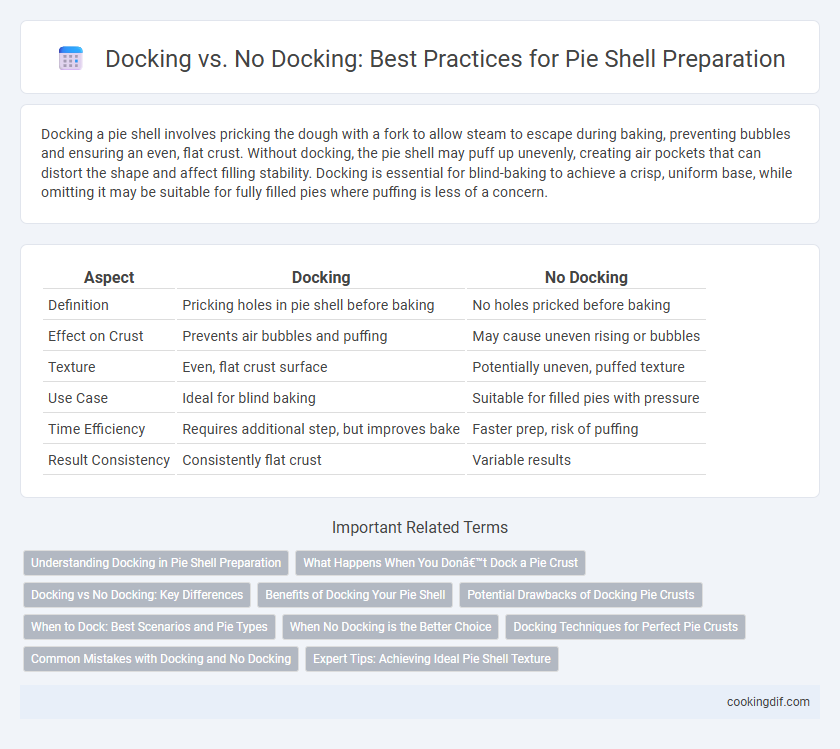Docking a pie shell involves pricking the dough with a fork to allow steam to escape during baking, preventing bubbles and ensuring an even, flat crust. Without docking, the pie shell may puff up unevenly, creating air pockets that can distort the shape and affect filling stability. Docking is essential for blind-baking to achieve a crisp, uniform base, while omitting it may be suitable for fully filled pies where puffing is less of a concern.
Table of Comparison
| Aspect | Docking | No Docking |
|---|---|---|
| Definition | Pricking holes in pie shell before baking | No holes pricked before baking |
| Effect on Crust | Prevents air bubbles and puffing | May cause uneven rising or bubbles |
| Texture | Even, flat crust surface | Potentially uneven, puffed texture |
| Use Case | Ideal for blind baking | Suitable for filled pies with pressure |
| Time Efficiency | Requires additional step, but improves bake | Faster prep, risk of puffing |
| Result Consistency | Consistently flat crust | Variable results |
Understanding Docking in Pie Shell Preparation
Docking in pie shell preparation involves pricking the dough with a fork or a docking tool to create small holes that allow steam to escape during baking, preventing the crust from puffing up or developing air bubbles. This technique is essential for achieving an even, flat crust, especially for pies with fillings that don't require blind baking. Skipping docking can result in uneven texture and undesirable bubbling, compromising the pie's structural integrity and presentation.
What Happens When You Don’t Dock a Pie Crust
When you don't dock a pie crust, steam builds up underneath the dough during baking, causing it to puff and create uneven bubbles. This results in a distorted pie shell that can affect the filling's distribution and overall texture. Docking allows steam to escape evenly, ensuring a flat, crisp crust that holds its shape and supports the pie filling properly.
Docking vs No Docking: Key Differences
Docking a pie shell involves pricking the dough with a fork, which prevents air bubbles by allowing steam to escape during baking, resulting in a flat, even crust. No docking can cause the crust to puff up unevenly, creating pockets of air but can add flakiness and texture to certain types of pies. The choice between docking and no docking depends on the desired crust texture and the type of filling used in the pie.
Benefits of Docking Your Pie Shell
Docking a pie shell creates small perforations that prevent air bubbles and uneven puffing during baking, ensuring a uniformly crisp crust. This technique promotes even heat distribution, reducing the risk of soggy or undercooked spots in the pie base. Enhanced texture and consistent baking results make docking essential for both sweet and savory pies.
Potential Drawbacks of Docking Pie Crusts
Docking pie crusts can cause excessive moisture loss, leading to overly dry or brittle shells that compromise texture. Piercing the dough creates weak points vulnerable to tearing or shrinking during baking, resulting in uneven crusts. Avoiding docking preserves the crust's moisture and structural integrity but may increase the risk of puffing or bubbling, which can be mitigated with controlled baking techniques.
When to Dock: Best Scenarios and Pie Types
Docking pie shells is essential for high-moisture fillings like custards and fruit pies to prevent bubbles and uneven rising during baking, ensuring a crisp bottom crust. For thicker, drier fillings such as pumpkin or pecan pie, docking is often unnecessary as the filling sets without excessive steam buildup. When making blind-baked shells destined for creamy or delicate fillings, docking combined with pie weights ensures structural integrity without puffing or cracking.
When No Docking is the Better Choice
No docking is the better choice for pie shells with high-moisture fillings, such as fruit pies, because it prevents juices from leaking through the crust during baking. Leaving the pie shell undocked allows steam to escape naturally, reducing the risk of a soggy bottom crust and maintaining a tender, flaky texture. This method preserves the structural integrity of delicate or partially pre-baked shells where ventilation holes could cause uneven cooking or cracking.
Docking Techniques for Perfect Pie Crusts
Docking techniques involve piercing the pie dough with a fork or docking tool to allow steam to escape during baking, preventing the formation of air bubbles and ensuring an even, flat pie crust. This method is essential for blind baking or when a crisp, tender base is required, as it promotes uniform heat distribution and reduces puffing. Avoiding docking can lead to uneven baking, with bubbles and raised areas that disrupt the crust's texture and appearance.
Common Mistakes with Docking and No Docking
Common mistakes with docking pie shells include over-piercing, which can cause excessive moisture loss and a cracked crust, and uneven docking patterns that lead to incomplete steam release. No docking often results in a soggy bottom crust because trapped steam creates pockets of moisture, preventing even baking. Both approaches require balanced technique to maintain a crispy texture and prevent bubbling or cracking during baking.
Expert Tips: Achieving Ideal Pie Shell Texture
Docking pie shells creates small holes that allow steam to escape, preventing sogginess and ensuring a crisp, flaky texture. Skipping docking may result in a puffed, uneven crust due to trapped steam, ideal only for certain fillings that require a puffier base. Expert bakers recommend docking to balance moisture retention with a tender, perfectly baked pie shell.
Docking vs no docking for pie shell preparation Infographic

 cookingdif.com
cookingdif.com